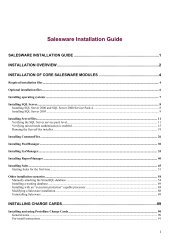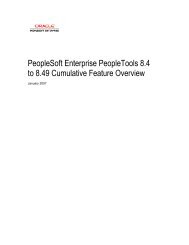COGNOS Business Intelligence Series 7
pes.pdf
pes.pdf
Create successful ePaper yourself
Turn your PDF publications into a flip-book with our unique Google optimized e-Paper software.
Chapter 3: Control Processes<br />
Example 3: Daisychaining<br />
In the configuration depicted below, a cube can be processed on any of the three computers,<br />
depending on how busy each processor is.<br />
The cube is configured with a source and a mirror reference. The mirrored cube is in turn<br />
configured with another mirror reference. By setting the Maximum Processes property for each<br />
cube to suit your processing needs, you can prevent queues on any of the computers. This<br />
configuration also establishes an order of preference for processing the cube, which always starts<br />
with the local computer.<br />
There are many custom configurations for mirror references that you can take advantage of to<br />
control processing. Consider experimenting with typical cubes and reports and monitoring the<br />
processes before moving to a full production environment.<br />
To manage your processing requirements effectively, remember that the processing of the cube or<br />
report takes place on a computer with a query or report processor, regardless of where the actual<br />
source resides. The .ppx or .mdc file may reside on another computer. However, requests are<br />
returned faster when the cube or report resides on the same computer that processes them.<br />
Monitor Processes<br />
PowerPlay Enterprise Server processes cubes with the query processor, and processes reports with<br />
the report processor. A new instance of a processor is started when all of the following conditions<br />
exist:<br />
• all available processors are busy handling requests<br />
• an additional request is received<br />
• the maximum number of processes set has not been reached<br />
In addition, connections from a PowerPlay Windows application can start another instance of the<br />
query processor depending on the value of the Scheduling Threshold (p. 88) setting.<br />
Windows<br />
In Windows, use the Windows Task Manager to monitor processes. The query processor is named<br />
Ppdsweb.exe, and the report processor is named Pprp.exe.<br />
You can also use the Performance Monitor to obtain more status and performance information.<br />
For information about the Performance Monitor, see the Microsoft Windows documentation.<br />
Do not use Windows Task Manger to end PowerPlay processes. Disable the associated cube using<br />
PowerPlay Enterprise - Server Administration or the ppadmtool command-line interface.<br />
UNIX<br />
In UNIX, use the monitoring tool for your version of UNIX or use one of the following<br />
commands to monitor processes:<br />
• ps -ef | grep process (on IBM AIX and HP-UX)<br />
• ps -ax | grep process (on Sun Solaris)<br />
The query process is named ppdsweb, and the report process is named pprp.<br />
PowerPlay Enterprise Server records server activity which can help you track processor usage over<br />
time.<br />
Enterprise Server Guide 31
















